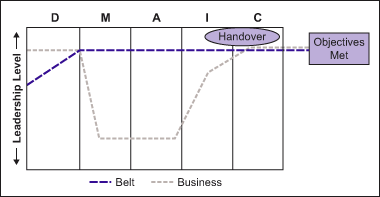
Initially Six Sigma process improvement projects followed four phases: Measure, Analyze, Improve and Control. Today, some companies still omit the Define phase because a project’s definition is seen as mainly management work. Following this logic, the same might be true for Control: ensuring that the process improvements are implemented and monitored is only a business responsibility. “MAI” would be enough as a project roadmap if business did its job. The Define and Control phases are seen as an integral part of the Six Sigma project roadmap, however, not in order to shift the responsibility for their execution to the project leader but to build the bridge between the business and the project. Define is the initialization and handover of the project by the line function to the project organization. Control is the handover in the other direction.
If business does not play an integral role at the beginning and the end of each project problems occur:
- No involvement in the Define phase increases the risk of scope creeping, working on the wrong problems, long project duration and missing support from important stakeholders.
- No business lead in Control means that change does not happen – solutions are not fully implemented, the people involved in the process do not adapt the changes, key performance indicators (KPIs) and business case are not achieved.
It is, therefore, key to the success of the project that business takes the lead in the Define and Control phase. The figure below shows the necessary involvement of the business (sponsor and process owner) and project leader (Belt) in a Six Sigma project along the DMAIC phases.
Define Phase Tasks
The ordinary tasks of the sponsor and process owner in Define are:
- Select a project with a significant impact on business.
- Create and validate a business case that expresses the value of the project in quantified financial or strategic terms.
- Communicate clearly to the organization the strategic view and the need for change. (Why is the project a priority?)
- Determine the necessary metrics to measure the problem and the success of the project.
- Set the project goal based on business need, client need, benchmarking and process baseline data.
- Ensure Belt and team members’ availability, and include the process owner as part of the team from the beginning.
If the business leaders do not complete these activities it may indicate the business has not determined the worth of the project. The sponsor and process owner must provide the “what” and “why” of the project. The project leader will define the “how” following the DMAIC methodology. Too often, the focus during the Define phase switches too quickly from the business problem to the process without project leaders understanding how a process improvement would contribute to a strategic business goal. The Define phase should be more business-centered than process-centered.
Define Tools
The following Define tools help determine the business value of a project:
- A project charter serving as a contract between the sponsor and Belt that confirms quantified goals and expected results as well as the team members’ availability.
- A business case describing the quantified financial outcomes of the project as approved by the sponsor and a financial analyst.
- The voice of the customer to understand the business needs from all important internal and external customers of the project.

As shown in the figure above, the involvement of the business has to start in Improve – the business people create, evaluate and select the improvement solutions and implement them therefore taking ownership. In Control and beyond, the business should be back in a leadership position. The sponsor and process owner need to ensure that the original business idea is realized. The business has to guarantee that the results of the defined KPIs and business case are achieved and sustainable. It is not possible to sustain business results on a project level.
Control Phase Tasks and Responsibilities
The main tasks of the business people in Control are for the sponsor:
- To provide financial and human resources to implement the solutions
- To ensure that the KPIs defined become part of the personal objectives of the process owner
Additionally, the process owner must communicate with and influence the people involved in the process to facilitate change, for only if people change behavior can the results be sustainable. The process owner and his team must implement the process changes and monitor the KPIs on a frequent basis. Finally, the financial analyst needs to confirm and validate the financial results achieved.
In the Control phase the business needs to answer the questions “When will the changes be implemented?” and “How much is the finally realized business case?”
Control Tools
The most important Six Sigma tools in the Control phase are:
- The process management chart to clarify process ownership responsibilities as well as key leading and lagging metrics to measure the process performance
- The dashboard to monitor the most important KPIs
- Control charts and statistical tests to show based on data the sustainability of the solutions
- The updated business case to demonstrate based on the implemented solutions the true costs and financial benefits of the process improvement
Conclusion
Instead of building a complex deployment-monitoring dashboard to boost the results of deployment, a business must do two things: 1) stop sending project leaders to training before their sponsors are trained in their role in the process and the philosophy behind the method and 2) stop asking company Belts to provide the business case, the goal definition, the implementation follow up or other business related deliverables – it is not their job. Six Sigma projects are business projects and what needs to be done in Define and Control is first and foremost a business responsibility.